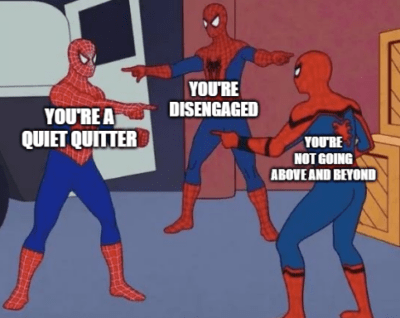Want to deter quiet quitting? Create an enriching work environment that engages employees
Is quiet quitting a new phenomenon, or is it simply a new term to describe an existing workplace problem?

‘Quiet quitter’ is a label lumped on employees who’ve had enough of the long hours, office politics, and little appreciation, committing to only do the bare minimum required to keep their job. What was once referred to as being actively disengaged, ‘quiet quitting’ repackages employee engagement and shifts the blame for creating an inclusive and enriching work environment to the individual, rather than the organisation. What a cop out!
Post-pandemic, times have changed. And organisations are missing the point entirely.
Here’s what’s really behind quiet quitting, and how you can flip the script and create a workplace where employees want to go above and beyond.
What is quiet quitting 2.0, exactly?
You could say that quiet quitting is simply when an employee rejects the idea that work should be the central focus of their life. Where once workers responded to outlandish requests and expectations to go above and beyond with a people pleasing ‘yes’ by default, the 2022 employee is much more considered about how they spend their time.
And we can probably thank the global pandemic, lockdowns and forced remote working for this major mindset shakeup.
Employees are now facing once-in-a-generation challenges: working longer hours and giving more of themselves (sometimes with increased feelings of isolation due to the absence of much loved in-office interactions), while also enjoying more time at home where home time and work time can blend.
Quiet quitting (aka active disengagement) is likely to arise where the employer has failed to recognise and adapt to how much the work-life equation has changed.
The employer-employee relationship can’t be transactional

Traditionally, an organisation’s EVP was transactional.
If you give us your skills, we’ll reward you with money and free fruit.
But a years’-long pandemic and higher cost of living has created a new work-life equation centred around quality of life and wellbeing. Employees expect more from their workplace – not token gestures and quirky perks that don’t benefit their lives personally.
Employees need to feel seen, valued and included as individuals. They’re seeking an emotional connection to their work and the benefits, rewards, and recognition. In other words, a more human-centric relationship.
How to create a work environment where employees want to go above and beyond
One study indicates that quiet quitting is usually less about an employee’s willingness to work harder and creatively, and more about a manager’s ability to build a relationship with their employees where they’re not counting the minutes until quitting time. When the manager inspired them, they had a strong desire to do everything possible to accomplish goals and objectives (including working late or starting early when needed).
That’s because, for employees to feel like they want to go above and beyond, you have to create magic, you have to engage them. You have to make them feel emotionally connected to their task and way of work.
3 ways to boost employee engagement
🤝 Foster trust
Use open, honest, and transparent communication at all times. But you also need to support your employees personally and show them that you care about their wellbeing. For example, if you ask them to work longer days, are you communicating empathy and appreciation by also offering time off in recognition of their discretionary effort? Are you checking in during periods of high productivity and stress to make sure they’re not overwhelmed or burning out?
💝 Personalised connection and motivation
Annual engagement surveys won’t cut it. We’ve moved into an age of constant feedback – daily or weekly pulse checks to gauge mood and sentiment. This doesn’t always require full manual handling. You can rely on intuitive technology to start the pulse check, just be sure to pick the conversation up in person when an employee needs additional support.
You could also tailor your recognition efforts to individual motivators. Learn their appreciation language so you can provide rewards and recognition in a meaningful way that makes them blush with pride.
And finally, prioritise time nurturing team relationships and camaraderie, especially if managing a hybrid or fully remote team. It’s critical you maintain personable connections with individuals, and for individuals with each other (see how Cadrelo builds team camaraderie).
🤯 Rethink how we work
Is the time-based workweek dead? With remote and hybrid work now an obvious option, employees are demanding greater flexibility. But flexibility here doesn’t just mean location; it means working when, where, and how the individual can perform at their best.
For example, in one organisation, one employee starts at 3am, another at 11am, while another lives their dream of a working holiday traveling the world, clocking in at any hour but getting their work done.
Consider the merits of job sharing, flexible work time, flexible job descriptions, hybrid work, compressed work weeks, and work from anywhere to enable people to create a work-life equation that meets career and life goals.
Adapt to the new work-life equation to keep employees engaged

Employees need to be getting much more than a paycheck, which means their relationship with work and the environment you create must be more than the transactional deals you once got away with.
Respect the new work-life equation and create an enriching work environment, so employees never have to think about ‘quiet quitting.’


